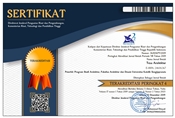STRATEGI PENAFSIRAN PUSAKA DI KEUSKUPAN AGUNG SEMARANG (STUDI KASUS SITUS RANDUSARI – SEMARANG)
Abstract
Abstract
Many studies on the preservation of cultural heritage have been carried out, but only focus on the physical aspect. Studies that only focus on the physical do not have the power to last long because conservation activities will only focus on how to return the investment on physical development. The research aims to find significance in the interpretation and meaning of heritage preservation which will form the basis of a comprehensive and sustainable conservation strategy. This study uses the Historical Interpretation Strategy (HIS) as part of the seven steps of Heritage Urban Landscape (HUL). History tracing is done by diachronic and synchronic methods. The case study was conducted at the Randusari site in the Archdiocese of Semarang by conducting field surveys, interviews, questionnaires and a Discussion Group Forum with the Archdiocese of Semarang, government officials and professional associations. This study finds significance in the interpretation of heirlooms and the meaning of heirlooms at the Randusari Site, such as Education, Youth, Humanity and Catholicism as the basis for conservation at the Randusari Site.
Keywords: Interpretation, significance, heritage, Randusari Site, meaning
Abstrak
Kajian pelestarian cagar budaya sudah banyak dilakukan, namun hanya berfokus pada aspek fisik saja. Kajian yang hanya menitikberatkan pada aspek fisik tidak memiliki kekuatan untuk bertahan lama karena kegiatan pelestarian hanya akan berfokus pada cara untuk mengembalikan investasi atas pembangunan fisik. Penelitian ini bertujuan untuk menemukan signifikansi dalam penafsiran dan makna pusaka pelestarian pusaka yang akan menjadi dasar strategi pelestarian yang komprehensif dan berkelanjutan. Penelitian ini menerapkan Strategi Interpretasi Sejarah (HIS) atau Strategi Penafsiran Pusaka sebagai bagian dari tujuh langkah Heritage Urban Landscape (HUL). Penelusuran sejarah dilakukan dengan metode diakronis dan sinkronis. Studi kasus dilakukan di situs Randusari di Keuskupan Agung Semarang dengan melakukan survei lapangan, wawancara, kuesioner dan Forum Grup Disscusion dengan Keuskupan Agung Semarang, pejabat pemerintah, dan asosiasi profesi. Kajian ini menemukan signifikansi dalam penafsiran pusaka dan makna pusaka di Situs Randusari yaitu Pendidikan, Kebaruan, Kemanusiaan, dan Katoliksitas sebagai dasar dalam pelestarian di Situs Randusari.
Kata kunci: Penafsiran, signifikansi, pusaka, Situs Randusari, makna
Keywords
Full Text:
PDF (Bahasa Indonesia)References
Bandarin, F, & Oers, R. Van. (2012). The historic urban landscape: managing heritage in an urban century.
Bandarin, Francesco. (2019). Reshaping Urban Conservation. https://doi.org/10.1007/978-981-10-8887-2_1
Buckley, K., Cooke, S., & Fayad, S. (2015). Using the Historic Urban Landscape to re-imagine Ballarat. Urban heritage, development.
Esquivel, A. A. O. (2019). Managing the landscape values of urban heritage: a critical analyisis of the UNESCO’s Recommendation on the Historic Urban Landscape in Valparaíso, Chile. oatd.org.
Haryono anton. (2009). Awal Mulanya adalah Muntilan (Prabawa Hendra (ed.); 1 ed.). Kanisius.
Heuken, A. . (2009). 150 Tahun Serikat Jesus berkarya di Indonesia.
Hoeven, A. Van der. (2019). Historic urban landscapes on sosial media: The contributions of online narrative practices to urban heritage conservation. In City, Culture and Society. Elsevier.
Ibtihal, Y., Raslan, R., & Mohsen, H. (2016). Conservation of Beirut’s Urban Heritage Values Through the Historic Urban Landscape Approach.
International, I. (2008). The ICOMOS Charter for the Interpretation and Presentation of Cultural Heritage Sites. October.
Kahn, A. (1973). Neutron activation and nutrition. In The Journal of the Arkansas Medical Society (Vol. 70, Nomor 5).
Kurniati, R., Ristianti, N. S., Dewi, S. P., & Prihestiwi, R. C. (2020). Transformation of Activities and Space in Malay Kampong as Heritage Kampong in Semarang City. Jurnal Teknik dan Perencanaan. https://doi.org/10.15294/jtsp.v221l.21498
Linden, J. van der. (1993). Donum Desursum.
Norbruis, O. (2020). Architecture From Indonesian Past,Life and Work of Fermont-Cuypers 1927 -1957 (1 ed.). LM Publshers.
Pérez, J. R., & Martínez, P. G. (2018). Lights and shadows over the Recommendation on the Historic Urban Landscape. Journal of Heritage Studies. https://doi.org/10.1080/13527258.2017.1362572
Piagam Pelestarian Pusaka Indonesia - Indonesian Charter for Heritage Conservation, (2003).
Rey-Pérez, J., & Roders, A. P. (2020). Historic urban landscape: A systematic review, eight years after the adoption of the HUL approach. Journal of Cultural Heritage Manajement. https://doi.org/10.1108/JCHMSD-05-2018-0036
Rogers, A. P. (2017). Historic urban landscape approach and living heritage. In Living Urban Heritage: Theoretical Considerations of. academia.edu.
Sarinastiti, A., Rukayah, R. S., & Murtini, T. W. (2015). Konsep Waterfront Pada Permukiman Etnis Kali Semarang. Teknik, 36(2), 61–67. https://doi.org/10.14710/teknik.v36i2.7023
Simon, R. I., & Ashley, S. L. T. (2010). Heritage and practices of public formation. Taylor & Francis. https://doi.org/10.1080/13527251003775471
Taylor, K. (2014). The historic urban landscape. Managing heritage in an urban century. Taylor & Francis. https://doi.org/10.1080/01426397.2014.909618
Tipnis, A. (2013). Shared urban heritage in India: the case of Chandernagore. Context.
UNESCO. (2016). The HUL Guidebook: Managing Heritage in Dynamic and Contantly Changing Urban Environments. The 15th World Conference of the League of Historical Cities, 59.
UNESCO, B. (2009). Protocols for Best Conservation Protocols.
Zubir, Z. (2002). Sawahlunto dan Pelestarian Multikultural : Sebuah Sumbangsih Pemikiran untuk Wisata Tambang Berbudaya.
DOI: https://doi.org/10.24167/tesa.v20i1.4780
ISSN 1410-6094 (Print) | ISSN 2460-6367 (Media Online) | View My Stats

This work is licensed under a Creative Commons Attribution 4.0 International License.









